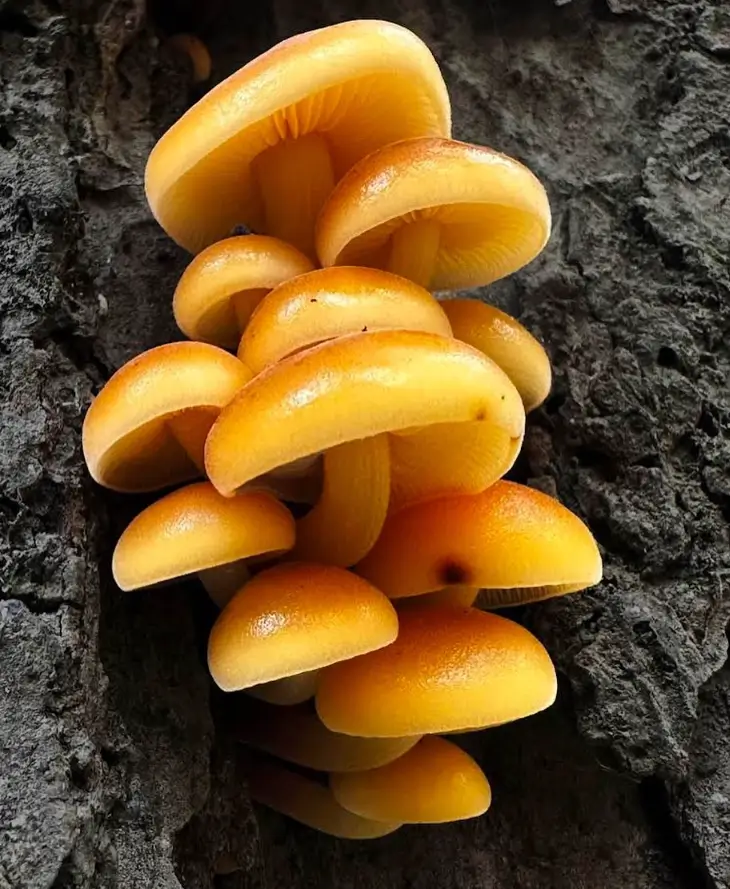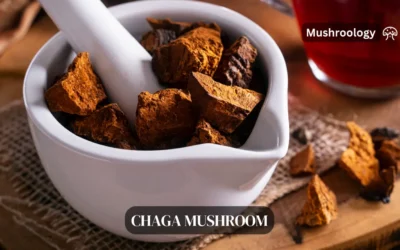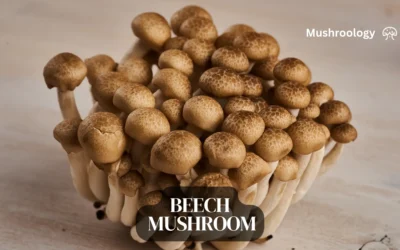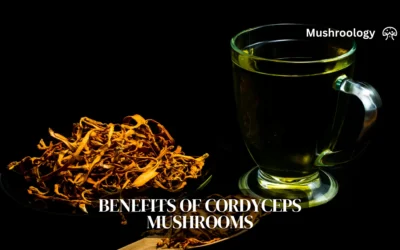Where do enoki mushrooms grow in nature?
Enoki mushrooms (Flammulina velutipes) naturally grow in various regions across the globe. They are predominantly found in:
- Eastern Asia: Enoki mushrooms have been growing wild since ancient times, particularly in countries like Japan, Korea, and China
- North America: They are also found in the wild across various parts of North America
- Europe: Enoki mushrooms grow in certain regions of Europe, including Great Britain and Ireland.
Enoki mushrooms grow naturally in various woodland settings. They are typically found on rotting wood, especially dead hardwood trees such as elm, willow, Chinese hackberry, persimmon, ash, and mulberry trees.
These mushrooms prefer cool temperatures and high humidity, so they are commonly found during the cooler parts of the year, such as late fall, early spring, and even mid-winter in milder climates.
It is important to note that wild enoki mushrooms can closely resemble toxic species, so proper identification, such as performing a spore print, is crucial when foraging.
Enoki Mushrooms taste and texture
Enoki mushrooms, scientifically known as Flammulina velutipes, have slender, elongated stems and small white caps, and are highly valued for their crunchy texture and delicate flavor.
Enoki mushrooms, or enokitake, have a distinct appearance that differentiates them from other mushroom varieties. The long, thin stems and tiny caps make them easily recognizable. They have a mildly sweet, nutty taste and a crisp texture, making them a delicious addition to various culinary dishes.
Key Characteristics of Enoki Mushrooms:
Enoki mushrooms are versatile in the kitchen, offering a range of culinary possibilities. From soups and stir-fries to salads and sushi, they add a unique texture and flavor to various dishes. Their delicate appearance also makes them an attractive garnish for plates, adding a touch of elegance to meals.
| Characteristics | Details |
|---|---|
| Scientific Name | Flammulina velutipes |
| Common Names | Enoki mushrooms, Enokitake |
| Appearance | Slender, elongated stems with tiny white caps |
| Taste and Texture | Mildly sweet, nutty flavor with a crunchy texture |
| Nutritional Value | Low in calories and fat, rich in fiber, vitamins, and minerals |
| Culinary Uses | Raw in salads, added to soups, stir-fries, and other dishes |
In the following sections, we will explore the different varieties of enoki mushrooms, the ideal growing conditions, and the step-by-step process of cultivating these delicious fungi.
How to Select the Right Enoki Mushroom Varieties
Different enoki mushroom varieties have distinct characteristics and specific growing requirements.
White Enoki Mushrooms
Scientific Name: Flammulina velutipes var. velutipes
The traditional white enoki mushrooms are the most commonly cultivated worldwide. These mushrooms have small, slender stems and tiny white caps, making them visually appealing. They are known for their delicate flavour and crisp texture, perfect for adding a unique touch to salads, stir-fries, and soups.
Golden Enoki Mushrooms
Scientific Name: Flammulina velutipes var. lutescens

The golden enoki mushrooms, also known as lutescens or wild velvet shank, have a vibrant golden color. They have longer and thicker stems compared to the white variety but maintain the same small cap size. These mushrooms have a slightly earthier and nuttier flavor, making them a delicious addition to various dishes.
Other Enoki Mushroom Varieties
In addition to the white and golden enoki varieties, there are other less common varieties available. These include pink enoki mushrooms, which have a distinct pink hue, and brown enoki mushrooms, which have a darker cap color. While these varieties may have unique flavors and appearances, they generally require more specialized growing conditions and are less commonly cultivated at home.
When selecting the right enoki mushroom variety for your cultivation project, consider factors such as flavor preferences, visual appeal, and growing requirements.
How to grow enoki mushrooms at home?
Several crucial factors are to consider, including temperature, humidity, light, and ventilation. Let’s dive into each of these elements to understand how they contribute to the optimal conditions for growing enoki mushrooms.
Temperature
Temperature plays a vital role in the growth and development of enoki mushrooms. They thrive in cooler temperatures, ideally between 45 to 60°F (7 to 15°C). Maintaining a consistent temperature within this range is important to ensure proper fruiting and avoid stress on the mushrooms. A temperature-controlled environment, such as a dedicated mushroom growing room or a temperature-regulated greenhouse, can help you achieve optimal results.
Humidity
Enoki mushrooms require high humidity levels to encourage vigorous growth. Aim for relative humidity (RH) of around 85-95% during the cultivation process. This can be achieved using a humidifier or regularly misting the growing area. Be mindful of not creating excess moisture, which can lead to fungal contamination. Adequate airflow and ventilation play a crucial role in maintaining the ideal humidity levels while preventing the buildup of stagnant air.
Light
Unlike some other mushroom varieties, enoki mushrooms benefit from exposure to light during their growth. Natural light is the ideal source, but artificial lighting can be used if not available. Position grow lights at a distance and angle that mimics natural daylight to provide the mushrooms with the necessary light spectrum for proper development. Aim for 12-16 hours of light per day during the cultivation period to promote healthy and robust enoki mushrooms.
Ventilation
Proper ventilation is essential to prevent the buildup of carbon dioxide and promote air exchange within the growing environment. Good airflow helps to maintain a healthy microbial balance and prevents the growth of contaminants. Consider using fans or installing an exhaust system to ensure consistent air circulation. However, be cautious not to create excessively turbulent air that could harm the delicate enoki mushroom clusters.
Select the suitable substrate for your enoki mushrooms
Enoki mushrooms thrive in specific environments that provide the necessary nutrients and support. In this section, I will discuss the different options available for cultivating enoki mushrooms and help you select the most suitable growing medium for your cultivation setup.
The Pros and Cons of Different Growing Mediums
There are several growing mediums commonly used for enoki mushroom cultivation, including sawdust, straw, or a combination of both. Each medium has its own advantages and disadvantages that you should consider before making a decision.
Sawdust
Sawdust is a popular choice for growing enoki mushrooms. It provides a stable, easily controlled environment for mushroom growth. Sawdust is relatively free from contaminants and can be easily sterilized. However, it may require additional supplements to provide sufficient nutrients for optimal mushroom development.
Straw
Straw is another commonly used medium for enoki mushroom cultivation. It is rich in nutrients and provides a good substrate for mushroom growth. Straw is more readily available and less expensive compared to sawdust. However, it can be more prone to contamination and requires thorough pasteurization before use.
Combination
Some growers prefer to use a combination of sawdust and straw to create a balanced growing medium. This allows them to take advantage of the benefits of both mediums while minimizing their respective drawbacks. The combination provides a diverse and nutrient-rich substrate for robust mushroom growth.
Choose the most suitable substrate for your enoki mushrooms
When selecting the substrate for enoki mushrooms, consider your specific circumstances and resources. It can be an excellent choice if you have access to high-quality sawdust and the necessary equipment for sterilization. Alternatively, if you have access to clean, nutrient-rich straw and can effectively pasteurize it, straw might be the better option for you.
Remember, proper sterilization or pasteurization techniques are crucial to minimize the risk of contamination in any chosen growing medium. Following best practices and maintaining a clean, sterile environment will greatly increase your chances of successful enoki mushroom cultivation.
To help you visualize the pros and cons of each growing medium, here is a summary in the form of a table:
| Growing Medium | Pros | Cons |
|---|---|---|
| Sawdust | Stable environment, easily controlled, low contamination risk | Potential nutrient supplementation required |
| Straw | Rich in nutrients, readily available, cost-effective | Pasteurization required, higher contamination risk |
| Combination | Utilizes the benefits of both mediums, diverse substrate | Requires resources for both sawdust sterilization and straw pasteurization |
Preparing the Substrate
After selecting the appropriate substrate it is crucial to properly prepare it to create optimal conditions for enoki mushroom growth. By following these essential steps, you can minimize the risk of contamination and ensure the healthy colonization of your enoki mushrooms.
Sterilization Techniques
Sterilization is a critical step in preparing the growing medium for enoki mushrooms. It eliminates any potential harmful microorganisms that could compete with the mushroom mycelium. There are several sterilization techniques you can use:
- Heat Sterilization: The most common method involves using heat to kill off any contaminants. It can be done by pressure cooking or using an autoclave. Make sure to follow the manufacturer’s instructions and sterilize the growing medium thoroughly.
- Chemical Sterilization: Another option is to use chemicals such as hydrogen peroxide or bleach to sterilize the medium. However, this method requires caution and proper dilution to prevent damage to the growing medium and the mushrooms.
Substrate Preparation
Once the growing medium is sterilized, it’s time to prepare the substrate for the enoki mushrooms. Substrate refers to the material on which the mushroom mycelium will grow. Common substrates for enoki mushroom cultivation include sawdust, straw, or a combination of both. Here’s how to prepare the substrate:
- Sawdust Substrate: If you’re using sawdust, start by soaking it in water for 24 hours. Drain the excess water and mix it with vermiculite or another nitrogen-rich supplement to enhance the nutrient content. Blend the mixture thoroughly and transfer it to a sterilized container or bag.
- Straw Substrate: If you’re using straw, chop it into small pieces and soak it in hot water for 1-2 hours. Drain the water and pasteurize the straw either by steaming or placing it in an oven at a specific temperature. Once pasteurized, spread the straw out to cool before transferring it to a container or bag.
- Combination Substrate: For a combination substrate, blend the soaked and pasteurized ingredients together, ensuring an even distribution of sawdust and straw. This combination allows for a balanced nutrient composition that promotes proper enoki mushroom growth.
Remember to maintain a clean and sterile environment throughout the preparation process to prevent contamination. Once your growing medium is prepared, you’re ready to proceed with the enoki mushroom cultivation process.
Inoculating the Growing Medium
Inoculation plays a crucial role in the cultivation process of enoki mushrooms. It involves introducing enoki mushroom spawn into the growing medium, kickstarting the colonization process. There are different methods of inoculation available, such as using grain spawn or sawdust spawn. Let’s explore these methods in detail.
1. Grain Spawn Inoculation
One method of inoculating the growing medium is by using grain spawn. Grain spawn consists of sterilized grains, such as millet or wheat, that have been inoculated with enoki mushroom mycelium. Here’s how you can use grain spawn for inoculation:
- Prepare a clean working area and ensure proper sterilization of tools and equipment.
- Take a clean container and fill it with the desired growing medium, such as sterilized sawdust or a sawdust-straw mixture.
- Using clean hands or sterile gloves, evenly distribute the grain spawn throughout the growing medium.
- Ensure that the grain spawn is evenly spread, allowing for optimal colonization.
By following these steps, you can successfully inoculate the growing medium with grain spawn, providing a favorable environment for enoki mushroom growth.
2. Sawdust Spawn Inoculation
Another method of inoculation involves using sawdust spawn. Sawdust spawn consists of enoki mushroom mycelium grown on sterilized sawdust particles. Here’s how you can use sawdust spawn for inoculation:
- Prepare a sterile environment for working and ensure all tools and equipment are properly sterilized.
- Take a clean container and fill it with the selected growing medium, such as sterilized sawdust or a sawdust-straw mixture.
- Spread a layer of sawdust spawn evenly over the growing medium.
- Gently mix the sawdust spawn into the growing medium, ensuring even distribution.
By following these steps, you can successfully inoculate the growing medium with sawdust spawn, creating favorable conditions for enoki mushroom colonization and growth.
During the inoculation process, it is crucial to maintain a sterile environment to prevent contamination. Proper sterilization of tools, containers, and working surfaces is essential to ensure successful inoculation. Additionally, following good hygiene practices, such as wearing clean gloves, can further minimize the risk of contamination.
Manage the Growing Conditions
Once the growing medium is inoculated with enoki mushroom spawn, it is crucial to carefully manage the growing conditions to ensure healthy mushroom growth and maximize your yield. By monitoring and adjusting key factors such as temperature, humidity, watering, and pest management, you can create an optimal environment for your enoki mushrooms to thrive.
Temperature and Humidity Control
Enoki mushrooms have specific temperature and humidity requirements to grow successfully. Optimal temperature for enoki mushroom cultivation is between 50°F and 60°F (10°C and 15°C), while humidity levels should be maintained at around 85% to 95%. These conditions can be achieved by using a dedicated growing chamber or by utilizing tools such as humidifiers and fans. It is essential to regularly monitor the temperature and humidity levels to ensure they remain within the desired range.
Watering
Proper watering is crucial for enoki mushroom growth. The growing medium should be kept consistently moist, but not overly wet, to prevent mold growth and ensure the mushrooms receive enough water for development.
Avoid using cold or chlorinated water, as it can inhibit mushroom growth. Instead, opt for filtered or dechlorinated water at room temperature. Regularly check the moisture content of the growing medium and adjust watering as needed.
Pest Management
Pests and diseases can threaten the health and productivity of your enoki mushroom crop. Common pests in enoki mushroom cultivation include mites, flies, and gnats. Regularly inspect the growing area and mushrooms for any signs of pests or diseases. Proper sanitation practices, such as keeping the growing environment clean and promptly removing contaminated or damaged mushrooms, can help prevent infestations. Consider using organic pest control methods, such as beneficial insects or natural pest repellents if necessary.
By managing the growing conditions diligently, you can provide your enoki mushrooms with the ideal environment for healthy growth and abundant yields. Stay vigilant with temperature and humidity control, adjust watering practices to maintain proper moisture levels, and take proactive measures to prevent and manage pests. With these techniques, you’ll be on your way to cultivating thriving enoki mushrooms in no time.
Harvesting and Storage Techniques
Knowing when and how to harvest enoki mushrooms is crucial to enjoy them at their peak freshness and flavor. In this section, I’ll guide you through the harvesting process, including proper techniques for cutting and handling the delicate mushroom clusters. Additionally, I’ll discuss the best practices for storing harvested enoki mushrooms to prolong their shelf life.
Harvesting Enoki Mushrooms
When it comes to harvesting enoki mushrooms, timing is everything. Harvesting the mushrooms when they reach a desirable size, typically around 2-4 inches in length is recommended. The caps should still be tightly closed, and the stems should be slender and firm.
To harvest enoki mushrooms, simply use a sharp knife or pair of scissors to cut the mushroom clusters at the base of the stems, where they meet the growing medium. Be gentle and avoid damaging nearby mushrooms or the growing medium.
When harvesting, it’s important to remove both the mushrooms and any remaining mycelium (the white, thread-like structure) from the growing medium. This helps prevent the accumulation of decaying matter, which can negatively impact future mushroom flushes.
Handling Enoki Mushrooms
Enoki mushrooms have delicate, slender stems that require careful handling to avoid damage. To preserve their quality, it’s recommended to gently brush off any excess dirt or substrate using a soft brush or a damp cloth. Avoid washing the mushrooms with water, as they can become waterlogged and lose their flavor.
After cleaning, separate the mushroom clusters into individual stems for easier cooking and presentation. Enoki mushrooms are often used in stir-fries, soups, and salads, and their unique texture and flavor can enhance a variety of dishes.
How to store Enoki Mushrooms
Proper storage is essential to prolong the shelf life of harvested enoki mushrooms. Here are some best practices to follow:
Refrigerate: Place the harvested mushrooms in a paper bag or a breathable container and store them in the refrigerator. This helps maintain their freshness and prevents moisture buildup that can lead to spoilage.
Enoki mushroom shelf life
Enoki mushrooms typically have a shelf life of 7 to 14 days when stored properly. Here are the key details regarding their shelf life and storage:
- They should be stored at temperatures between 7-10°C (44.6-50°F) for optimal freshness. For short-term storage (7 days or less), a temperature range of 34-36°F (1-2°C) with 90-98% relative humidity is recommended.
- Look for dark spots, slimy texture, discoloration, or unpleasant odors as indicators of spoilage.
Enoki mushrooms can be frozen, but their delicate texture may be compromised. If freezing, blanch them in boiling water for about a minute, then transfer to an ice bath before drying and storing in an airtight container. Frozen enoki mushrooms can last up to three months.
| Harvesting and Storage Techniques | Benefits |
|---|---|
| Harvesting enoki mushrooms when they reach the desired size | – Ensures optimal freshness and flavor – Prevents overripe or underdeveloped mushrooms from being harvested |
| Gently cutting the mushroom clusters at the base of the stems | – Minimizes damage to the delicate stems – Facilitates future mushroom flushes |
| Properly cleaning and handling enoki mushrooms | – Preserves the delicate texture and flavor – Removes excess dirt or substrate – Enhances culinary presentation |
| Storing harvested enoki mushrooms in a paper bag or breathable container in the refrigerator | – Maintains freshness and extends shelf life – Prevents moisture buildup and spoilage – Allows for efficient organization and space utilization in the refrigerator |
Troubleshooting Common Issues
Even with the best practices in place, enoki mushroom cultivation may encounter certain challenges. In this section, we will address common issues that growers may face and provide practical solutions to overcome them. By being aware of these potential problems and knowing how to troubleshoot them, you can ensure the success of your enoki mushroom cultivation endeavors.
1. Contamination
Contamination is a common problem in mushroom cultivation, including enoki mushrooms. It can occur due to improper sterilization techniques, contaminated growing mediums, or unclean working environments. To prevent contamination:
- Ensure that all equipment and the cultivation area are properly cleaned and sanitized before starting the cultivation process.
- Use a reliable sterilization method, such as pressure cooking or steam sterilization, to sanitize the growing medium.
- Avoid cross-contamination by keeping different batches of mushrooms separate and using clean tools for each batch.
If you encounter contamination, it’s crucial to act quickly to prevent further spread. Remove the contaminated materials and sterilize the affected area before starting again with fresh supplies.
2. Slow or Stunted Growth
Slow or stunted growth can be frustrating for growers. Several factors can contribute to this issue:
- Temperature: Enoki mushrooms thrive in cooler temperatures. Ensure that the growing environment maintains a temperature of around 50-55°F (10-13°C).
- Humidity: Enoki mushrooms require high humidity levels. Maintain humidity between 85-95% by misting the growing area regularly and using a humidifier, if necessary.
- Light: Enoki mushrooms prefer low light conditions. Avoid exposing them to direct sunlight or intense artificial light.
- Nutrition: Check the nutrient content of your growing medium. Enoki mushrooms typically grow best in nutrient-rich substrates such as sawdust supplemented with bran or wheat straw.
By adjusting these factors, you can promote healthier and faster growth of your enoki mushrooms.
3. Disease Management
Enoki mushrooms can be susceptible to various diseases, including fungal, bacterial, and viral infections. Proper disease management techniques are crucial to maintaining a healthy crop:
- Isolate infected mushrooms to prevent the spread of disease. Remove and dispose of affected mushrooms carefully.
- Maintain proper ventilation to reduce humidity and prevent the growth of fungal pathogens.
- Use disease-resistant varieties when possible.
- Practice good hygiene by regularly cleaning and sanitizing the cultivation area and equipment.
Remember, prevention is key when it comes to disease management. By implementing good cultivation practices and monitoring your crop closely, you can minimize the risk of diseases and ensure the health and productivity of your enoki mushrooms.
Expand Your Enoki Mushroom Cultivation
Now that you have mastered the basics of enoki mushroom cultivation, it’s time to take your skills to the next level. In this section, I will provide you with valuable insights on how to expand your cultivation efforts and explore advanced techniques that can maximize your enoki mushroom yield. Additionally, I will share tips on turning your passion for growing enoki mushrooms into a small business opportunity.
Scale Up Your Cultivation Operation
Once you have successfully grown enoki mushrooms on a small scale, you may consider scaling up your operation to meet higher demands. Here are some key steps to help you expand your cultivation:
- Assess your space: Determine the available space you have for larger cultivation setups, such as a greenhouse or a dedicated growing room.
- Invest in equipment: Upgrade your equipment to accommodate larger quantities of growing medium, spawn, and harvest tools.
- Optimize your workflow: Streamline your cultivation process by implementing efficient systems for inoculation, maintenance, and harvesting.
- Manage your resources: Plan your cultivation cycles and allocate resources effectively to ensure consistent production.
Exploring Advanced Cultivation Techniques
As you gain experience in enoki mushroom cultivation, you may want to explore advanced techniques to enhance your yields and experiment with different growing methods. Here are some techniques to consider:
- Alternative growing mediums: Experiment with alternative growing mediums like wood chips or compost to diversify the flavors and textures of your enoki mushrooms.
- Cold shocking: Cold shock your enoki mushrooms by exposing them to lower temperatures for a short period, enhancing their aesthetic appeal and promoting denser growth.
- Hydroponic cultivation: Explore hydroponic systems specifically designed for growing enoki mushrooms, which offer precise control over nutrient levels and environmental conditions.
Turning Your Passion into a Small Business
If you have a deep passion for enoki mushroom cultivation, you may even consider turning it into a small business venture. Here are some steps to get started:
- Market research: Identify your target audience and research the demand for enoki mushrooms in your local market.
- Develop a business plan: Outline your goals, strategies, and financial projections to give your business a solid foundation.
- Build a network: Establish connections with local restaurants, farmers’ markets, and grocery stores to expand your customer base.
- Brand your business: Create a unique brand identity that reflects the quality and sustainability of your enoki mushrooms.
- Continuous learning: Stay updated with the latest advancements in enoki mushroom cultivation techniques and market trends to stay ahead of the competition.
Expanding your enoki mushroom cultivation can open up exciting opportunities for growth and success. Whether you choose to scale up your operation, explore advanced techniques, or turn your passion into a small business, remember to stay dedicated, adaptable, and always ready to learn. With the right mindset and perseverance, your enoki mushroom cultivation journey can lead to both personal fulfillment and financial prosperity.
FAQ
What are enoki mushrooms?
Enoki mushrooms, scientifically known as Flammulina velutipes, are a popular edible fungus native to East Asia. They have slender, elongated stems and small white caps, and are highly valued for their crunchy texture and delicate flavor.
How do I select the right enoki mushroom varieties for cultivation?
Enoki mushrooms come in different varieties, each with its unique characteristics and growing requirements. Some popular enoki mushroom varieties include white enoki and golden enoki. It’s important to choose the variety that suits your cultivation setup and preferences.
What elements should I consider when creating the ideal growing environment for enoki mushrooms?
Temperature, humidity, light, and ventilation are crucial elements to consider when creating the ideal growing environment for enoki mushrooms. Maintaining the right conditions will promote optimal growth and yield.
What are the suitable growing mediums for cultivating enoki mushrooms?
Enoki mushrooms can be cultivated using different growing mediums, such as sawdust, straw, or a combination of both. Each medium has its advantages and drawbacks, so it’s important to choose the most suitable one for your cultivation setup.
How do I prepare the chosen growing medium for enoki mushroom cultivation?
Proper preparation of the growing medium is essential for successful enoki mushroom cultivation. This involves sterilization techniques and substrate preparation to minimize the risk of contamination and promote healthy mushroom colonization.
What are the methods of inoculating the growing medium with enoki mushroom spawn?
Inoculation involves introducing enoki mushroom spawn to the prepared growing medium. This can be done using different methods, such as grain spawn or sawdust spawn. Maintaining a sterile environment during this stage is crucial for successful inoculation.
How do I manage the growing conditions for enoki mushrooms?
Proper care and management of the growing conditions are important for healthy enoki mushroom growth. This includes controlling temperature and humidity, watering appropriately, and managing pests effectively.
When and how should I harvest enoki mushrooms?
Harvesting enoki mushrooms at the right time and using proper techniques is crucial to enjoy them at their peak freshness and flavor. This section will guide you through the harvesting process and provide tips for handling the delicate mushroom clusters.
What are common issues in enoki mushroom cultivation and how can I troubleshoot them?
Common issues in enoki mushroom cultivation include contamination, slow or stunted growth, and disease management. By being aware of these potential issues and knowing how to troubleshoot them, you can overcome obstacles and achieve successful cultivation.
How can I expand my enoki mushroom cultivation?
Once you have mastered the basics of enoki mushroom cultivation, you may want to expand your operation. This section will provide insights into scaling up your efforts, exploring advanced techniques, and potentially turning your passion for enoki mushroom growing into a small business.





